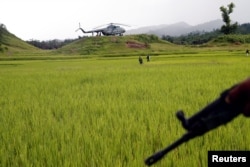The bodies of Hindu villagers were put on display Wednesday during an official trip for the press to view two mass graves in Rakhine State. Myanmar authorities told the reporters the victims were killed by the militant Arakan Rohingya Salvation Army (ARSA).
The military organized the trip and transported members of the press from Yangon to an area near Yebaw-kyar village in the Kamaung-seik town in the Maungdaw District. VOA Burmese reported seeing the two mass graves found Sept. 24 and 25. Twenty-eight bodies were disinterred from the first site, and 17 from the second.
Grieving relatives watched over the bodies, which were lined up on a grassy slope amid paddy fields. The toll included women and children.
The victims had been blindfolded with their hands tied and their throats slit, according to VOA Burmese.
Accusations and denials
According to the military, ARSA killed the villagers Aug. 25, the same day the group raided police outposts and drew a heavy military response.
VOA Burmese could not confirm this account, nor was it possible to verify separate allegations that the military was involved in massacring the Hindus.
What actually took place remains unclear: Who carried out the killings and what sparked an attack on Hindus living in a majority-Muslim area?
ARSA posted a statement on Twitter Wednesday categorically denying that its members “perpetrated murder, sexual violence, or forcible recruitment” in late August. The group called on the army to stop “victim-blaming.”
Villager helped find graves
U Maw Ni, a Hindu villager who helped authorities find the graves, told VOA that he learned about the burial site from eight Hindu women who had been threatened with death by ARSA militants unless they agreed to convert to Islam.
The women, who were taken from Rakhine State to the Kutupalong refugee camp in Bangladesh, described the massacres and the location of the graves, U Maw Ni said, and he then sought help from authorities.
“We followed the paths based on the information we got,” police officer Okkar Ko said, according to Reuters. “We found where the soil wasn’t normal, and then when we dug up the ground, the smell came out,” he told reporters at the scene.
In Photos: VOA Burmese Visits Mass Grave Site
More than 500,000 people, roughly half the Rohingya population in Rakhine State, have fled to neighboring Bangladesh to escape persecution since deadly violence began nearly a year ago, most of them left in the last three weeks. Satellite imagery released by Human Rights Watch last week shows massive swaths of scorched landscape and the near total destruction of 214 villages.
On Thursday, diplomats and representatives from the United Nations will be allowed to visit Rakhine State for the first time since the latest violence erupted. The U.N. has labeled the Rohingya one of the world’s most persecuted religious minorities.
Though members of the ethnic minority first settled in that area of western Burma bordering Bangladesh generations ago, Rohingya were stripped of Burmese citizenship and almost all of their rights in 1982. Since then they have been stateless. They cannot travel freely, practice their religion, or work as teachers or doctors, and they have little access to medical care, food or education.
In a speech last week, Myanmar leader Aung San Suu Kyi did not address a U.N. statement that the army has engaged in a “textbook case” of ethnic cleansing. Instead, she told concerned diplomats that while many villages were destroyed, more than half were still intact.
VJ Sithu contributed to this report which originated on VOA Burmese









